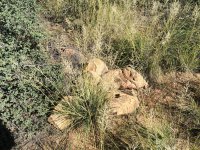Holyground
Hero Member
- May 17, 2014
- 579
- 828
- Detector(s) used
- Garrett AT GOLD, Garrett ATX
- Primary Interest:
- All Treasure Hunting
In 1548, Philip II issued the Ordenanzas del Nuevo Cuaderno that for the first time clearly applied the laws of Spain to its New World colonies and gave the viceroys authority to issue implementing ordinances as required by local circumstances. Based on this authorization, the first comprehensive mining ordinance for the New World was issued by Viceroy Mendoza on January 14, 1550. This law contained 49 separate provisions and was apparently Viceroy Mendoza's attempt to codify the existing royal pronouncements as he understood them in the framework of a practical mining code for use in New Spain. The essential process was as follows: The discoverer of a mineral deposit was permitted a single claim of 80 varas (a vara is approximately 32 inches) along the strike, or length on the surface, of the vein and 40 varas across the vein. All claims registered after the original discovery were restrict- ed to a smaller claim of 60 varas along the vein and 30 varas across. Each miner was prohibited from having more
than two mines within 1,000 varas ofthe original discovery except by purchase. The original locator had 15 days within which to register his find, the failure of which resulted in the loss ofthe right to the larger claim. In the case ofcon- flicting claims, the first to register the claim became the owner and where the requests for registration were simultaneous, the claimants were required to draw lots.
After the registration process was complete, the claim holders were required to sink a shaft of three estados (or approximately 18% feet) within three months, and the claim boundaries were required to be marked with stakes of one-half vara in height together with posting of a notice on the claim. The failure to erect these monuments car- ried a fine of ten pesos (a peso at the time contained approximately three-quarters of an ounce of silver).

This may be all there is in the actual mine area. Try looking for the corner boundaries of a claim in a really rocky area. There are no real carved monuments that I know of, off of the main trail into a mine location. The King of Spain advised them that he wanted mines marked much like they are today, and that is where we got the basic protocol. Later different mining district set forth their own measurements and general rules but the marking system is pretty much the same, later becoming standardized. The Spaniards didn't have plastic pipe.
than two mines within 1,000 varas ofthe original discovery except by purchase. The original locator had 15 days within which to register his find, the failure of which resulted in the loss ofthe right to the larger claim. In the case ofcon- flicting claims, the first to register the claim became the owner and where the requests for registration were simultaneous, the claimants were required to draw lots.
After the registration process was complete, the claim holders were required to sink a shaft of three estados (or approximately 18% feet) within three months, and the claim boundaries were required to be marked with stakes of one-half vara in height together with posting of a notice on the claim. The failure to erect these monuments car- ried a fine of ten pesos (a peso at the time contained approximately three-quarters of an ounce of silver).

This may be all there is in the actual mine area. Try looking for the corner boundaries of a claim in a really rocky area. There are no real carved monuments that I know of, off of the main trail into a mine location. The King of Spain advised them that he wanted mines marked much like they are today, and that is where we got the basic protocol. Later different mining district set forth their own measurements and general rules but the marking system is pretty much the same, later becoming standardized. The Spaniards didn't have plastic pipe.
Last edited:



